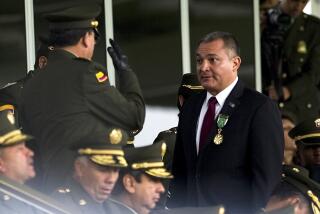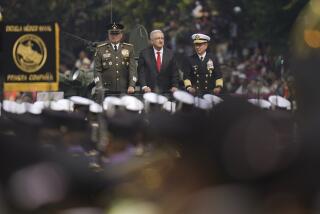âEl Chapoâ escape: âSometimes I think they are searching to not find himâ

Mexican authorities released security camera video footage July 14, 2015, showing the moment drug lord Joaquin âEl Chapoâ Guzman escaped from his cell in a maximum-security prison. (AP)
reporting from MEXICO CITY â In the massive manhunt for escaped drug lord Joaquin âEl Chapoâ Guzman, Mexican soldiers have been searching buses leaving Mexico City, a sprawling capital where itâs easy to hide, and headed into the town of Toluca â back toward the prison from which he fled.
In Guzmanâs home state of Sinaloa, the military has set up roadblocks and police have made a show of searching some homes.
But the response to the most-wanted criminalâs brazen prison escape Saturday has led some Mexicans to question how seriously the authorities are searching, especially given the apparent ease with which Guzman fled maximum-security detention and the governmentâs refusal to accept U.S. offers of additional help. Before the escape, Mexican officials had declined to extradite the head of the Sinaloa cartel to the more airtight custody of the United States.
âSometimes I think they are searching to not find him,â said Javier Valdez, a writer based in the Sinaloa capital of Culiacan who has studied cartel behavior for years.
U.S. federal law enforcement officials said Wednesday that they have offered drone technology and special agents to the hunt for the cartel leader since he slipped out of the Altiplano prison. Guzman broke out of another Mexican prison in 2001 and spent 13 years on the run before he was recaptured in Mazatlan last year in a joint operation by Mexican marines and U.S. agents.
Washingtonâs offers of assistance beyond standard sharing of information, however, have been rebuffed by Mexican authorities, who appear bent on capturing the fugitive on their own, U.S. officials said.
The American agents are perplexed and increasingly frustrated by Guzmanâs success in eluding Mexican justice. He escaped through an elaborate tunnel that had been dug under the shower stall in his cell; it led to a house newly built in an open field in plain sight of prison guards.
U.S. officials were also disturbed by the surveillance video of Guzmanâs cell. It shows him simply walking behind the shower wall, then disappearing.
âSomeone should have realized that was a blind spot for the camera,â said one official. âAnd guards should have come running in right there and then.â
Current and former U.S. law enforcement officials say the best chance for capturing Guzman would have been within 48 hours of his escape because his all-powerful cartel has the ability to quickly hide and protect him. They believe the fugitive probably has returned to the rugged Sinaloa mountains, where for years he ruled a worldwide drug operation estimated to net $30 billion a year in the U.S. alone.
U.S. and Guatemala authorities have said they are reinforcing their borders with Mexico. Several Mexican states have said they are doing the same, along with army or police patrols and airport stakeouts.
Miguel Angel Olvera, the security chief for the state of Durango, which borders Sinaloa and is part of the so-called Golden Triangle where Guzman reigned supreme, has put special surveillance on the mountainous region of Guanacevi, where it is thought Guzman hid out for long periods during his years on the run.
When Guzman was on the lam after the 2001 prison break, âthey used to call him the most-wanted fugitive. I laughed at that,â said writer Valdez. âNo one was really looking for him. Heâd pass through here, through [neighboring] Durango, leave the country easily.â
After Guzman was captured in February 2014 by Mexican marines equipped with U.S. intelligence, the American government said it wanted him extradited to the relative security of U.S. incarceration. Guzman and other members of his Sinaloa cartel have been indicted in seven U.S. federal court districts, including those headquartered in San Diego and Chicago.
Mexicoâs then-Atty. Gen. Jesus Murillo Karam immediately gave a resounding ânoâ to the U.S. suggestions of extradition. He cited national sovereignty, arguing that the Mexican judicial system was capable of prosecuting and punishing Guzman, predicting that he would ultimately be sentenced to more than 100 years behind bars.
Willfully or not, Murillo ignored the rampant corruption in the Mexican legal and judicial system that many suspect helped the billionaire kingpin break out again.
Mexicoâs Reforma newspaper, citing Mexican officials, reported after Guzmanâs latest escape that the United States was preparing extradition requests from six of the U.S. federal courts where he has been indicted. It was unclear, though, whether a formal petition was ever filed. The Justice Department has said only that extradition of Guzman âhas been a subject of ongoing discussions between the United States and Mexico.â
Mexico would be expected to resist extraditing Guzman, if he is recaptured and the U.S. formally seeks to prosecute him first, unless Washington promised not to seek the death penalty. Mexico, a predominantly Catholic country, does not have capital punishment.
Some experts suggest that under the previous government of conservative President Felipe Calderon, which was much more cooperative with Washington, Guzman would have been extradited. Calderon had allowed U.S. federal agents fairly free access to Mexican government installations in a coordinated battle against cartels and in efforts to train Mexican police, prosecutors and judges. American military sat alongside Mexican forces in intelligence-processing centers; State Department advisors worked in offices of the attorney general and federal police.
With the election in 2012 of President Enrique PeĂąa Nieto, that cozy relationship took on a more formal posture. The new administration, under the Institutional Revolutionary Party, greatly limited the access of U.S. officials and reduced cooperation.
In Washington, one senior Drug Enforcement Administration official said Wednesday that judicial authorities in the two countries talked Sunday, within 24 hours of the escape. âThey pledged their continued well-established cooperation focusing on his capture,â the DEA official said.
On Monday, the source said, Mexican and U.S. officials met privately in Mexico City and agreed to coordinate efforts. That was followed by a high-level meeting Tuesday between U.S. Ambassador to Mexico E. Anthony Wayne and Miguel Angel Osorio Chong, Mexicoâs interior minister. The Interior Ministry pledged to work with the U.S. and maintain open lines of communication âalways with respect for the law of sovereignty.â
But after those private meetings, Osorio Chong announced publicly that no additional U.S. aid was needed at this time. âWe are not going to do something new beyond what we have already been doing,â he said.
Authorities in the U.S. said that so far they have been turned away from having a large, public role in the manhunt, but are offering surveillance and other technological assistance to the Mexican army.
âWe may not be out there in the field with them, putting up roadblocks and running surveillance, but at the very minimum we are providing as much intelligence help as possible,â said Michael S. Vigil, a former longtime special agent for the DEA who supervised Mexico and Latin America operations. âIâve never seen a situation where they have not accepted our assistance.â
But, he added, âit should be their show. They are a sovereign country.â
Vigil and other U.S. sources said their best guess is that Guzman has returned to his Sinaloa mountain compound, where he can resume running his drug operations.
âThatâs his stronghold, that is the source of his power,â Vigil said. âAnd heâs protected by the local villagers there. Nothing moves unless he knows it first.â
Twitter: @TracyKWilkinson; @RickSerranoLAT
Wilkinson reported from Mexico City and Serrano from Washington. Times staff writer Carol J. Williams in Los Angeles contributed to this report.
More to Read
Sign up for Essential California
The most important California stories and recommendations in your inbox every morning.
You may occasionally receive promotional content from the Los Angeles Times.












